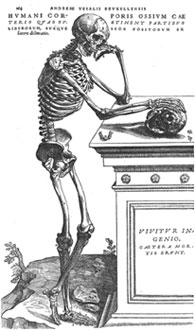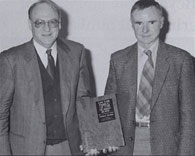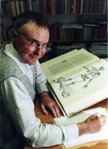Publications Anatomy: Vesalius’s On the Fabric of the Human Body

 Emeritus Professor John Carman (Anatomy) and Dr. Will Richardson (Classics) have collaborated on the translation of the sixteenth-century work by Vesalius—On the Fabric of the Human Body. Here, John Carman details the process of ensuring anatomical accuracy in the translation of this most important work.
Emeritus Professor John Carman (Anatomy) and Dr. Will Richardson (Classics) have collaborated on the translation of the sixteenth-century work by Vesalius—On the Fabric of the Human Body. Here, John Carman details the process of ensuring anatomical accuracy in the translation of this most important work.
 Translating the Fabrica is the major achievement of Will Richardson’s career. Photo courtesy of the New Zealand Herald.
Translating the Fabrica is the major achievement of Will Richardson’s career. Photo courtesy of the New Zealand Herald.
Latin opus into English
Courtesy of The University of Auckland News.
Volume 28, Number 5, July 1998.
“[The Cemetery of the Innocents in Paris was where] I began my study of bones, in company with Matthaeus Terminus…; there we found a rich supply of bones, which we examined indefatigably over a long period until we were able to make a bet with our fellow-students that, blindfolded, we could identify by touch alone any bone which they pulled from the piles over a half-hour period and handed to us. We were forced to these lengths because, though eager to learn, we had no teachers to assist us in this aspect of medicine.”
Thus wrote Andreas Vesalius in his On the Fabric of the Human Body, published in 1543. This monumental, seven-book tome is one of the most important books ever published in the history of medicine, as it revolutionized not only the science of anatomy but also the way it was taught. The “hands-on” principle of dissection—both as a method of learning and of teaching, has remained Vesalius’s most lasting contribution.
Written in Latin, the book has never been translated other than into Russian—until now, when Dr. Will Richardson (Classics and Ancient History) has undertaken to translate the entire Fabrica. It is a project he began five years ago, and the first fruit—Book I—has just been published through Norman Publishing.
The Latin initially guaranteed the book’s accessibility to an international medical and scientific audience—and right up until this century physicians would have had enough Latin to read bits of the original. The book remains a fixture in medical libraries around the world.
But the decline this century of Latin as the lingua franca of medicine would have doomed the book’s accessibility if it had not been for Will, who in a journal article reported that he had started work on the translation—and was thrilled then to be approached by Norman Publishing.
The project burgeoned into what he describes as “the major achievement of my scholastic life.” It is, of course, intellectually challenging: he generally translates about one page a day of the technical Renaissance medical Latin, passing on the draft to Emeritus Professor John Carman (Anatomy) to check the anatomical validity of his translation.
It would probably be difficult for most people to find the level of commitment to keep going: after five years of this disciplined approach, his book mark still only divides the original volume in half. Perhaps it is not surprising that a book this old and important has never before been translated: “The bulk of it has simply daunted people,” Will says.
Surprisingly, the work is also physically challenging. The original from which he is translating is an enormous tome, weighing 5.5kg—far too big to take to bed, but also too big to read comfortably at the table. So Will built himself a slanted stand to support the book, but nevertheless, he says, he has had to recourse to massages and gym workouts to sustain the strain on his upper body.
Vesalius’s Fabrica was a cornerstone of the Renaissance scientific revolution, and helped to break the stranglehold of the classical world upon the emerging world. Up until then, medicine had been based on the second century AD writings of Galen, the most famous physician of the ancient world. For 1500 years, Galen’s prolific writings formed the basis of all medical writings and until Vesalius no one had ever gone back to check the basics. In fact, much of Galen’s anatomy was based on the dissection of apes, not people, as it was not permissible for him to dissect human bodies. By Vesalius’s time, it had become socially permissible to perform human dissections, and this social fact coupled with Vesalius’s individual and inquiring mind, led to the breakthrough Fabrica.
Seven books make up the Fabrica although Will says the last five will fit into two or three volumes. He has not simply translated the Latin into Renaissance idiom, but into modern, easily readable English.
“It’s not too technical and not too dry. I want people to enjoy reading the book,” he says.
« back to all Anatomy Publications
back to top
